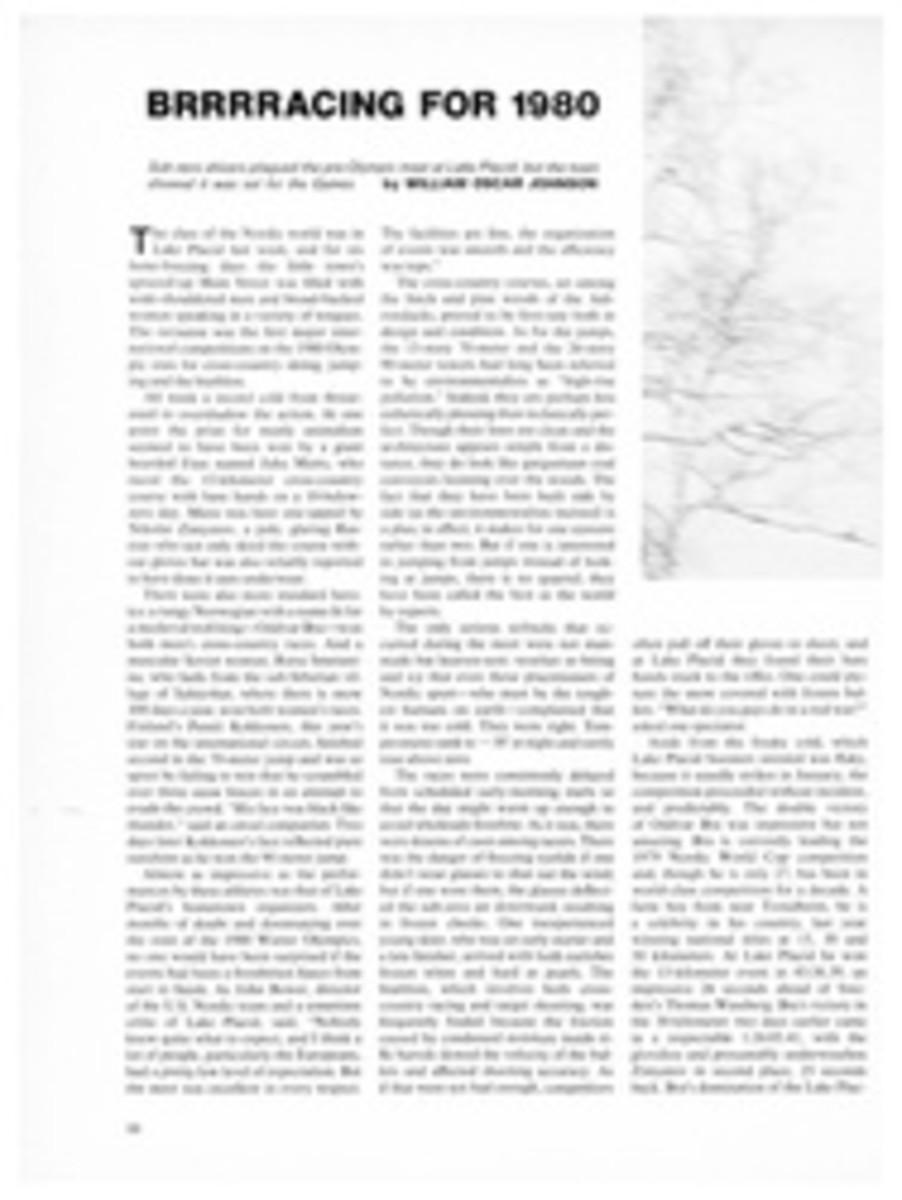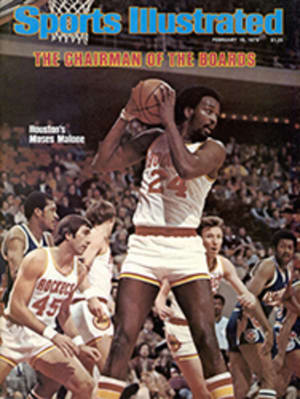
They fill a tall order
It's difficult to say just when 7-foot basketball players became so common that people stopped taking much notice of them. Almost no one asks a 7-footer how the weather is up there anymore, and when was the last time anyone referred to Wilt Chamberlain as Wilt the Stilt?
Well, in case you're still interested, the weather up there this year has been unseasonably good in the nation's high schools. The B/C Scouting Service of St. Petersburg, Fla. estimates that this season there are nine high school players who are at least seven feet tall, and another 54 who are 6'10" or better and could be 7-footers by the time they enter college. And this is such an upwardly mobile group that a lot of scouts are calling it the best class of big men ever.
The class of '79 is distinguished not only by its depth—or height, depending on how one looks at it—but also by the ability of its three best big men. They are, in more or less the order in which they have caused the heaviest drooling by recruiters: 7'1" Sam Bowie of Lebanon, Pa.; 7'3¼" Ralph Sampson of Harrisonburg, Va.; and 6'11¾" Steve Stipanovich of St. Louis.
Bowie is probably the most highly sought high school player since Moses Malone. Last week he was averaging 31.8 points and 18.4 rebounds, and was fresh off a 39-point performance against Manheim Township. Lebanon is in the heart of Pennsylvania Dutch country, and is notable for its 18th-and 19th-century architecture. Unlike the rest of Lebanon, the high school is a futuristic-looking honeycomb of three large circular pods connected by tunnels. But the invasion of the body snatchers that has been going on there for more than a year now has had less to do with pods than it does with Bowie, who has been contacted by at least 400 colleges.
Bowie's father Ben is 6'11" and a former member of the Harlem Magicians. He taught Sam to dribble and shoot 10 years ago, and the lesson stuck. Despite the overwhelming height advantage he has against most high school competition, Bowie does not simply camp underneath the hoop. He prefers to roam the baseline, where he can make use of his remarkable ball-handling ability and his feathery outside shot.
"Sam's goal is to play facing the basket in college," says Lebanon Coach Chic Hess. "He wants to be a forward, and some of the coaches of the schools he's interested in have told him he can play forward for them. But some of these guys will say whatever it takes to get Sam, and I know some of them are lying. Some of the coaches who are telling him he can be a forward come in here knowing that their teams need a center."
Kentucky Coach Joe Hall, whose school is one of eight that Bowie is considering, agrees that Bowie could play almost anywhere on the floor. "At a school that has a good big man," Hall says, "they'd get more mileage out of Sam by playing him in the corner." Says Bowie, "A lot of players my size are inside men only, and defenses are geared to collapse on them. Besides, I like to play outside better than I do inside."
Bowie's only weaknesses are that he does not get up and down the court quickly enough and that, at 215 pounds, he is too skinny. He is not the only big kid with a weight problem. Sampson is 2¼ inches taller and weighs 15 pounds less than Bowie. Still, Sampson is averaging 29.1 points and 19.6 rebounds, and one prominent coach, who is among the minority that rates Sampson over Bowie, says flatly, "Sampson is the best high school player in the country."
Jackie Allen, a recruiter for Virginia Tech, has been shadowing Sampson since his sophomore year. "With the players we already have, Ralph could take us to the final four next year," says Allen. '"He's as good as any big man ever to come along. He's ahead of Abdul-Jabbar, ahead of Malone, at this stage. Someday Ralph will be the standard by which all other big men will be measured."
Hall saw Sampson at a Kentucky basketball camp last August and says, "I never got tired of watching him. I don't think I've ever seen a player of his size with his ability. He has quickness and agility that you don't expect a player of his size to have."
Despite his height, Sampson may well be the best outside shooter on his state-championship team, and despite his lack of heft, he grabbed 34 rebounds in one game this season and 30 in another. He gets the ball off the boards in a hurry and makes the outlet pass quickly. Sampson has been contacted by 180 schools and is leaning toward Kentucky and Virginia, and away from Maryland. "At Maryland they have good players," Sampson says, "but after the Notre Dame game, which I went to with some teammates, the Maryland players all went separate ways. They didn't seem to be close. I think that could hurt a team."
Steve Stipanovich added the "h" to the end of his name this year because, he says, it is in the original Serbian spelling. But a Stipanovich by any other name would probably still be getting 25.5 points and 15 rebounds a game. More important, Stipanovich has led DeSmet—a Catholic high school—to a 22-0 record this year and 50 consecutive victories over the past two seasons. At 240 pounds, he is expected to be more of a power player in college than either Sampson or Bowie. DeSmet practices are opened to recruiters on Wednesdays, and on the first Wednesday of this season, coaches Digger Phelps of Notre Dame, Bill Foster of Duke, Norm Stewart of Missouri and Ron Ekker of St. Louis, and scouts from Kentucky, North Carolina and Southern Illinois were sitting in the bleachers. Phelps, who is said to believe he has Stipanovich locked up was in St. Louis last Friday night to see the youngster score 20 points and grab 20 rebounds in a 51-32 victory over St. Louis University High.
Performances like that may be a pleasure for Bowie's. Sampson's and Stipanovich's coaches to watch, but they hardly enjoy the aftereffects: each has been deeply involved in trying to shield his player and the boy's family from recruiting pressures. Roger Bergey, the Harrisonburg coach, has even mailed a full-page list of rules to schools interested in Sampson. They include such stipulations as no phone calls to the coach after 11 p.m. and no direct contact with Sampson or his parents until an appointment has been arranged by the school. Bergey's final commandment reads. "All recruiting violations will be reported to the NCAA."
"I think recruiting should be done in an orderly, honest and ethical manner," he says. "You read about it all the time—kids running and hiding, phones being taken off the hook, even people moving."
"It turns into chaos when the kid or his parents try to handle it," says Lebanon's Hess. "When there are no guidelines to follow, the kid is like a piece of meat, and there are a lot of hungry dogs pulling at him." Last January the Bowies changed unlisted phone numbers three times; the recruiters ferreted the number out each time and continued to pester the family.
It is a pattern that is being repeated all over the country as colleges go after other blue-chip prospects. Among the best of the rest are Tim Andree, a 6'10" senior at Brother Rice in Birmingham, Mich.; 6'11" Greg Kite of Madison High in Houston; 6'11" LaSalle Thompson of Cincinnati Withrow, who scored 40 points the last time a team didn't play a zone against him; 6'11" Michael Pitts of Sweetwater High in National City, Calif., and Ron Burns, a 7-footer who is averaging 23.4 points and 11.8 rebounds at Foss High in Tacoma, Wash.
And what the heck, coach, if you don't get any of these guys, you can still look forward to Troy Hitchcock or Patrick Ewing, a couple of 16-year-olds. Hitchcock, a ninth-grader in Columbus, Ohio, is already 7'1" and should weigh far more than his current 150 pounds by the time he gets to college in 1982. Ewing, a sophomore at Cambridge (Mass.) Rindge-Latin High, is a mere 6'11" now but, if projections hold, he will grow to 7'3". With guys like these in the pipeline, the NBA may junk its college farm system and start tapping kids directly out of junior high.
TWO PHOTOS
The best young pivots, Bowie (above) and Sampson, stand 7'1" and 7'3¼", respectively.

